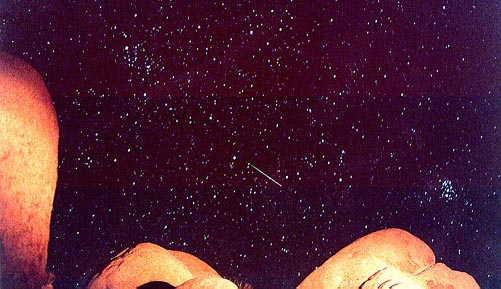Credit & Copyright: W. Pacholka
Explanation:
You're in no danger. During the meteor storm occurring tonight and tomorrow,
thousands of bits of ice and rock will likely rain onto the
Earth.
Few, if any, will
hit the ground.
Touted as potentially the most active
meteor shower since
1966, the
Leonids of 1998 will be tracked by
observers the world over.
The meteor storm is caused by the Earth
moving through the leftover debris of
Comet Temple-Tuttle.
The peak of the storm will be best
visible tomorrow from Asia, though increased activity should be
visible globally over many hours.
It is even possible to
monitor the
storm live on the web. Pictured above is a
Perseid 1997 meteor streaking across the
sky behind an illuminated California desert.
1999 2000 2001 2002 2003 2004 2005 2006 2007 2008 2009 2010 2011 2012 2013 2014 2015 2016 2017 2018 2019 2020 2021 2022 2023 2024 2025 |
Yanvar' Fevral' Mart Aprel' Mai Iyun' Iyul' Avgust Sentyabr' Oktyabr' Noyabr' Dekabr' |
NASA Web Site Statements, Warnings, and Disclaimers
NASA Official: Jay Norris. Specific rights apply.
A service of: LHEA at NASA / GSFC
& Michigan Tech. U.
|
Publikacii s klyuchevymi slovami:
Leonids - storm - meteor - Meteornyi potok - meteornyi dozhd' - Leonidy - kometa Tempelya-Tuttlya
Publikacii so slovami: Leonids - storm - meteor - Meteornyi potok - meteornyi dozhd' - Leonidy - kometa Tempelya-Tuttlya | |
Sm. takzhe:
Vse publikacii na tu zhe temu >> | |
